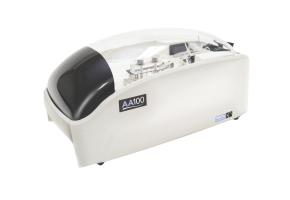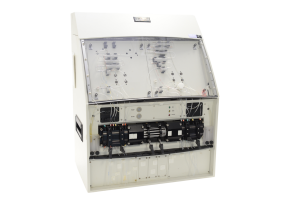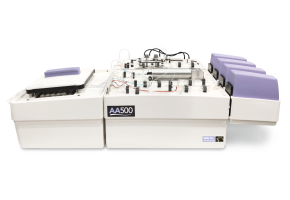AutoAnalyzer II (Legacy System)
Introduced in 1969, the Technicon AutoAnalyzer II was the 20th century's best known and most successful Continuous Flow Automated Analyzer, and the instrument that most EPA methods reference. Predecessor to the SEAL Analytical AA3 and AA500, it laid the groundwork for the widespread popularity of segmented flow analysis.
.jpg?resolution=325x0&quality-95&trim=1)
The 20th Century Benchmark in Continuous Flow Analysis
The Technicon AutoAnalyzer II (AAII) stands as the 20th century's most renowned and impactful Continuous Flow Analyzer—an instrument that fundamentally transformed laboratory operations and set the standard for automated nutrient analysis. Introduced by Technicon® in 1969 and later acquired by Bran+Luebbe in 1987, the AAII was at the heart of countless environmental and industrial methods, including those published by the U.S. Environmental Protection Agency (EPA). This legacy instrument was the platform on which many EPA-approved colorimetric methods were originally written and is still referenced today, ultimately shaping global testing protocols in water, soil, plant, food, beverage, and fertilizer analysis.
Before the AutoAnalyzer II (and the original AutoAnalyzer), manual analysis was slow, cumbersome, and prone to error. The AAII’s innovative segmented flow analysis (SFA) technique—with air bubbles separating continuous flows of sample and reagent—dramatically increased throughput, reduced operator hands-on time, and improved consistency in nutrient and trace element testing. Capable of running 30–60 samples per hour at flow rates of 2–3 mL/min, the AAII reshaped laboratories’ capabilities, making hundreds or even thousands of tests per day not just possible, but routine.
Continued Support & Transition to Modern Systems
Ready to Upgrade or Need Assistance?
Whether you’re maintaining an AAII still running strong or exploring a transition to more advanced continuous flow analyzers, SEAL Analytical is here to help. The AA500 is the latest generation in the AutoAnalyzer line, ready to automate the same methods as the AAII with increased flexibility and automation. Alternatively, a discrete analyzer may be a better fit for your evolving laboratory needs. Contact our experts for guidance on service, parts, and upgrades, and learn how our latest solutions can elevate your laboratory’s nutrient analysis capabilities.
.jpg?resolution=1200x650&quality=95)
Ongoing Assistance for a Scientific Icon
Today, even though the AAII is no longer manufactured and was replaced by the AutoAnalyzer 3 (AA3) in 1995 and later the AA500 in 2017, these instruments still remain in active use. SEAL Analytical continues to fully support AAII users. Although many parts are no longer obtainable, we supply parts as able and consumables as well as provide factory-trained service and technical support.
(1).jpg?resolution=1200x650&quality=95)
The AA500: Advancing the Tradition
Building on the solid foundation established by the AAII and then the AA3 and AA3 HR, the AA500 represents the latest generation of continuous flow analysis technology. It inherits the AutoAnalyzer family's robust performance, inline sample pretreatment abilities, and ultra-low detection limits, while offering full start-up to shut-down automation, a smaller footprint, and a simplified workflow. With Multi-Test manifolds and a host of advanced features, the AA500 sets a new standard for efficiency, accuracy, and versatility in nutrient analysis—making it a natural upgrade for laboratories ready to embrace modern capabilities.
Other models
Frequently Asked Questions
Below, we’ve listed a few frequently asked questions that will help you better understand our Continuous Flow Analyzers. If you don’t find the answer you're looking for, please don't hesitate to contact our support team for further assistance.
Our continuous flow analyzers can analyze samples at up to 120 samples/hour per channel, for a total of up to 600 tests per hour.
Our continuous flow analyzers utilize segmented flow analysis, injecting controlled bubbles at a regular interval which provides several benefits. The bubbles reduce carryover by adding physical separation between sample and wash solution, they improve the mixing of sample and reagent in-between air bubbles, they scrub the inner surface of the glass coils as the move along, and they provide a visual of the flow through the system for easy fluidic checks.
Segmented flow analysis and flow injection analysis are both types of continuous flow analysis. In segmented flow analysis, a gas bubble is injected into the sample stream at regular intervals (see question above). In flow injection analysis, samples an reagents are pumped into a manifold under pressure without any air bubble injection. Each type of continuous flow analysis uses different methods for analyzing the peaks charted as samples pass through the detector. We discuss these differences in detail here.
With minimal moving parts, segmented flow analysis has an advantage in requiring little routine maintenance. The maintenance involved includes rinsing out the channels after each run using the defined cleaning protocols for the chemistry ran on the instrument, releasing the platen so the pump tubes are not compressed when not in use, changing the flow-rated pump tubes at 200 hours of use, and keeping the pump clean and lubricated. Each SEAL analyzer comes with checklists and visual guides for these easy procedures, and our technical support team is always happy to assist with any questions.
Related articles
.jpg?resolution=428x267&quality=95)
.jpg?resolution=428x267&quality=95)
.png?resolution=428x267&quality=95)
Ready to get started on your next AutoAnalyzer?
Request Information
Fill out the form below to request information about our products and services.

.png?resolution=290x200&quality=95)


